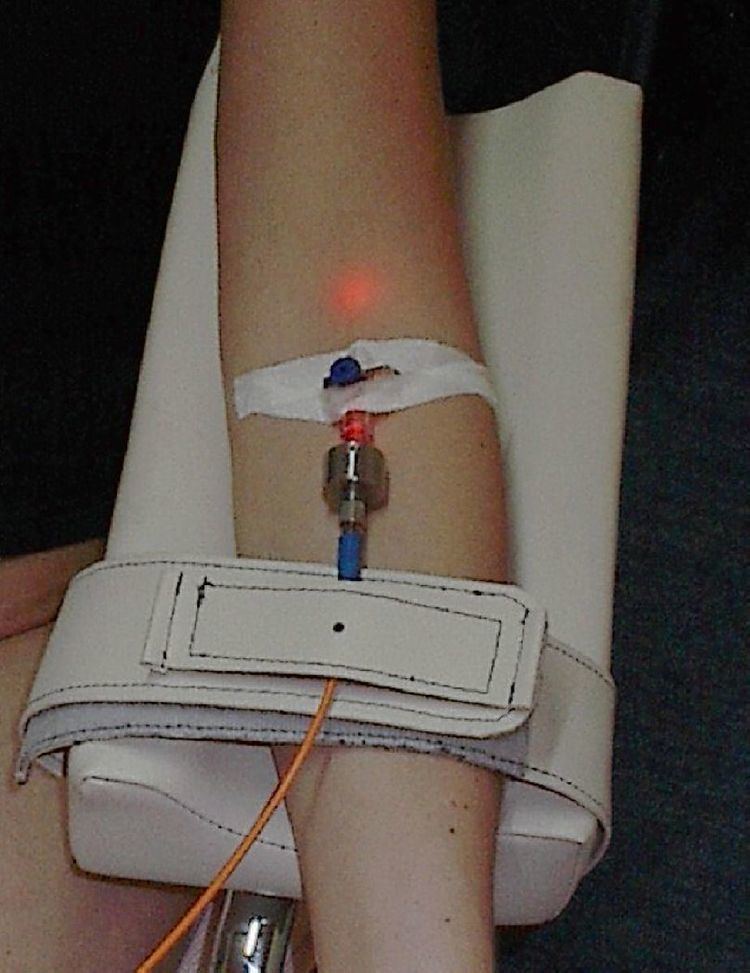 | ||
Blood irradiation therapy is a procedure in which the blood is exposed to low level red light (often laser light) for therapeutic reasons. Most research on blood irradiation therapy has been conducted in Germany, (by UV lamps), and in Russia (in all variants) while smaller-scale research has been performed in other countries such as Britain.
Contents
- History
- Intravenous laser blood irradiation
- Transcutaneous laser blood irradiation
- Extracorporeal irradiation
- References
Blood irradiation therapy can be administered in three ways. Extracorporeally, drawing blood out and irradiating it in a special cuvette. This method is used for the ultraviolet (UV) blood irradiation (UVBI) by UV lamps. The laser light is monochromatic, ie. it has such a wavelength that allows you to bring light into the optical fiber and carry out irradiation intravenously through a catheter in a vein. This method is more simple and effective. Blood irradiation therapy is also administered externally through the skin on the projection of large blood vessels.
It is not related to the practice of gamma irradiation of blood in transfusion medicine.
History
Historically, German doctors were the first to irradiate blood by UV lamps in the 20s of last century, and UVBI is widely spread in Germany so far. In the USA, this technique was best known during the Second World War. Intravenous laser blood irradiation (a more effective and modern variant) was developed experimentally by the Russian researchers, Meshalkin and Sergievskiy, and introduced into clinical practice in 1981. Originally the method was applied in the treatment of cardiovascular abnormalities. but it is now used in the treatment of a wide range of diseases.
Intravenous laser blood irradiation
Intravenous or intravascular laser blood irradiation (ILBI)involves the in-vivo illumination of the blood by feeding low level laser light generated by a 1–3 mW helium–neon laser at a wavelength of 632.8 nm into a vascular channel, usually a vein in the forearm, under the assumption that any therapeutic effect will be circulated through the circulatory system. Most often wavelengths of 365, 405, 525 and 635 nm and power of 2.3 mW are used. The technique is widely used at present in Russia, less in Asia, and not extensively in other parts of the world. It is shown that ILBI improves blood flow and its transport activities, therefore, tissue trophism, has a positive effect on the immune system and cell metabolism. This issue is subject to skepticism, but only in the part of the researchers, who are not acquainted with scientific publications on the topic, the vast majority of which are in Russian. There have been some calls to increase research on this topic.
Transcutaneous laser blood irradiation
Transcutaneous therapy applies laser light on unbroken skin in areas with large numbers of blood vessels (such as the forearm). Because of the skin acting as a barrier to the blood, absorbing low level laser energy, the power of the laser is often boosted to compensate. The problem can be solved by using pulsed matrix laser light sources.
Extracorporeal irradiation
It is used only for ultraviolet blood irradiation, that involves drawing blood out through a vein and irradiating it outside of the body. Though promoted as a treatment for cancer, a 1952 review in the Journal of the American Medical Association and another review by the American Cancer Society in 1970 concluded the treatment was ineffective. Stephen Barrett, writing for Quackwatch, lists ultraviolet blood irradiation therapy as a questionable treatment.
